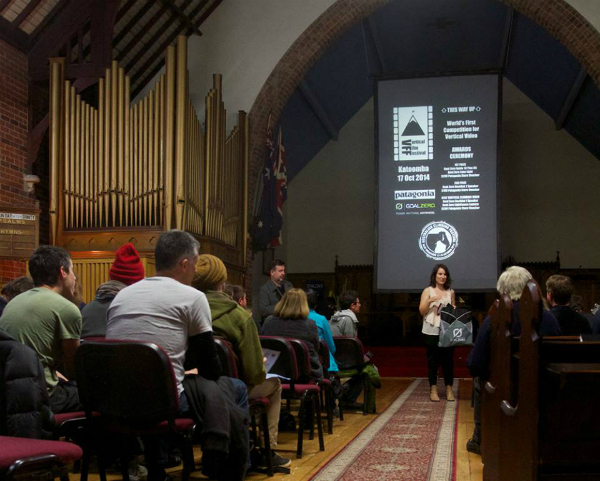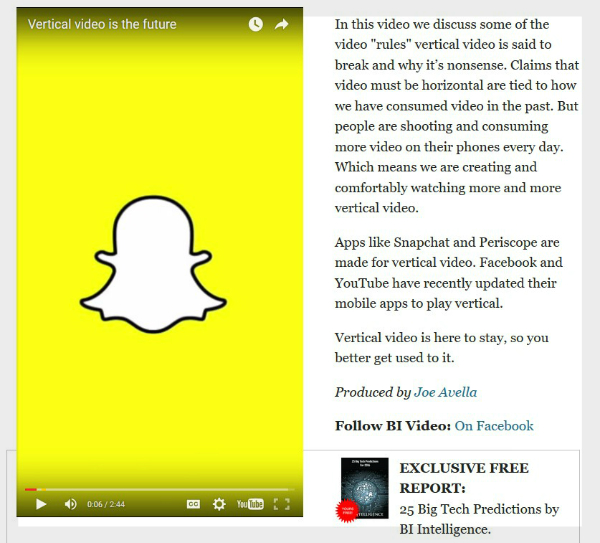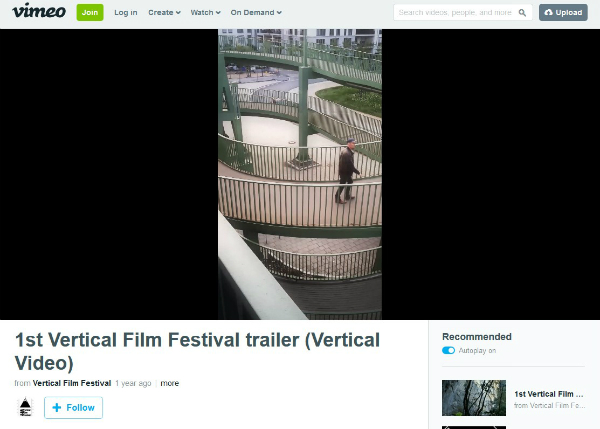
Trying to watch an entire video that was shot vertically might be like nails on a chalkboard to a design expert or videographer. However, much to their chagrin, vertical video has expanded well beyond Snapchat and isn’t going away anytime soon.
It seems to fly in the face common of sense, but a market has emerged for vertical video. Just a few years ago, most of us were making the switch from 4:3 monitors and television sets to widescreen versions. Now, a significant amount of the media we watch and interact with is being presented vertically, not horizontally.
How did this happen? You can credit (or blame) mobile devices for this movement. As our smartphones have gotten more powerful and as most families own at least one tablet device, we are quickly moving toward a mobile-first world.
Let’s take a look at the arguments for vertical video, why the format will likely be around for years to come, and how advertising and marketing departments can capitalize on the movement. But, before we do that, let’s look at why vertical video gets the goat of so many who claim to be experts in the aesthetics of moving imagery.
Why Vertical Video Sucks
You may have thought we’re living in a widescreen world, but the vertical video movement is pushing back at that notion.
How did this happen? A common complaint about trying to watch a video in this format goes to the effect of, “My eyes aren’t stacked vertically on my head!”
Yes, we naturally see the world horizontally. We generally like to see the full context and background of whatever subject on which we happen to currently have our focus. This explains why television screens and computer monitors have evolved to replicate, as closely as possible, our natural field of vision.
Yet, more and more people are serving up video in a vertical format. You can thank apps like Snapchat and Periscope for this phenomenon, or maybe just blame the orientation of smartphones and perhaps sheer laziness by their owners.
Vertical video has been getting on consumers’ nerves for several years now. Some even claim that the format is evidence of a rise of narcissism in society, since it’s usually one person filming themselves. In 2012, a popular video was released that claims to be a public service announcement on “Vertical Video Syndrome.”
“Vertical videos happen when you hold your camera the wrong way,” the lighthearted, humorous video says. “Your video will end up looking like crap,” it adds.
This so-called PSA came out about a year after the creation of Snapchat. Even then, its creators recognized that too many smartphone users were forgoing turning their devices sideways when shooting video. Today, vertical video is even more prominent, and many former horizontal advocates are finally giving in.
Perhaps the reason vertical video gets on the nerves of so many is quite a few of us think in terms of YouTube when consuming and producing visual content. A vertical video might play well on a phone, but once if it gets uploaded to YouTube, an excessive amount of pillarboxing (empty, black bars on the left and right) accompanies the footage inside the video player.
Why Vertical Video Does Not Suck
Let’s put aside any personal distaste for vertical video for a moment and take a level-headed look at why the format is excelling and why it legitimately has a place in today’s digital world.
Cellphones are getting larger and larger, and they’re getting harder to hold steadily in one hand, even for those of us with large hands. Turning the phone sideways to shoot video almost always takes two hands to operate the device, and there are certain times where that’s a luxury some users just don’t have. Shooting a video with the phone held upright can usually be accomplished with one hand, so there’s little reason to fault people for not being gung-ho about turning the phone horizontally.
Also, sometimes framing a video vertically just makes sense. It works for certain photos, after all. If you really want to get a tight focus on a single subject – a person or an object – then a vertical orientation could work really well. And it’s not just that it can work really well, it is working really well in the current smartphone- and tablet-laden environment, as more and more users are feeling comfortable with watching and shooting such videos.
This tweet sums up the best situations in which to shoot a vertical video:
Best uses for vertical video. #verticalvideo #filmmaking #womeninfilm pic.twitter.com/aQgwEMhoUu
— Suzette Mariel (@suzettemariel) February 26, 2016
Several Signs that Vertical Video Is a Legit Movement
You don’t have to look too far to see that vertical video is a viable movement and isn’t going away any time soon. Here are a few examples that extend beyond the realms of Snapchat, Periscope, Meerkat, etc.:
Vervid
Vervid is a website and iPhone app that allows users to create and share short videos with an aspect ratio of 9:16 (as opposed to the widescreen dimensions of 16:9). This company appears to be on a mission to make vertical video a mainstay.
Verly
Verly is an online marketplace for stock vertical imagery, with video clips available across 30 different categories and ranging in price from $15 to $79.
Vimeo
You will see pillarboxing around a vertically-shot video on the desktop version of Vimeo, but the video controls actually fit inside the narrow frame with the actual footage, rather than spread across the entire media player, as seen on YouTube.
Vertical Film Festival
The Vertical Film Festival takes place in Austrailia and features short, 9:16 submissions. The festival is actually coming up on its second annual celebration, which will take place on May 21, 2016.

Photo from the 1st annual Vertical Film Festival in Australia. (Facebook Photo/Vertical Film Festival)
Vertical Video Trailers
A YouTube account named “Vertical Video Trailers” has emerged, where it appears the account creator has just taken the traditional trailers of movies and cropped them to fit a vertically oriented device. These clips will have pillarboxing when viewed on a desktop, but if you take them full screen on your phone, they will fill out the available space.
The Stats Back it Up
If the above examples are a little too anecdotal to convince you of vertical video’s newfound prominence, let take a look at a few statistics provided by Snapchat and Verly:
- Vertical video ads are watched all the way through 9 times more than horizontal video ads on Snapchat.
- Smartphone users hold their phones vertically about 94 percent of the time.
- Brands that are producing vertical video are seeing a 73 percent average completion rate.
- Viewing of vertical content has jumped 600 percent over the last five years.
- More than 7 billion video clips are viewed daily on Snapchat, a majority of which are vertically filmed.
- Consumers use vertically oriented devices 30 percent of the time, up from just 5 percent in 2010. This means desktop, laptop and television screens aren’t dominating consumers’ attention the way they used to.
What About YouTube?
Last year, a Business Insider video producer created a vertical video about vertical video and embedded the YouTube version on his company’s website without any pillarbox showing.

This indicates that Business Insider must have adjusted the video embed code so the clip shows up perfectly on the page with its accompanying article. In fact, if I dig into the source code of the page, it looks like the width of the video player was changed to 400 pixels and the height changed to 711.
So, while you can manipulate the code of a vertical YouTube video to display correctly on your own site, it won’t look all too great on the popular video platform itself unless you’re viewing it on a phone and you make it full screen. If vertical video creators can eventually convince YouTube to fully cater to their 9:16 content, there’s no telling how far the format will continue to go. But, so far, YouTube is still a little behind the curve, whether intentionally or unintentionally.
How Advertisers, Marketers Can Capitalize on Vertical Video’s Success
Although you can certainly find examples of vertically-shot video and content pre-2010, the format’s viability is currently undeniable in today’s digital climate.
It’s still a rather fresh trend, so brands are still trying to figure out how to capitalize on the format’s success. If you’re in advertising or marketing, keep reading for a few ideas on how to get you started with creating and leveraging vertical video.
Leveraging Snapchat
Many media companies are on Snapchat Discover to provide video and photo content for users on this platform. Your company can try to get on Snapchat Discover, or if you’re a smaller business, you’ll just make a pleas for your Facebook or Twitter followers to find your Snapchat business account. Be sure to hide your phone number, as it will likely be one person whose personal phone will be logged in as the business.
However, make sure your business’s Snapchat Stories can be viewed by the public, not just “friends” of the company. If you can see Stories and individual snaps by users who have friended the company, feel free to interact appropriately and keep your brand on the mind of these users.
Shooting Other Vertical Content
Perhaps, your company periodically shares video to its social accounts, just maybe not vertically oriented clips. You can start changing that today.
Videos shot vertically will play well in Facebook, Twitter and now Instagram. You don’t always have to shoot such videos with a phone, either. You can use a higher-powered camcorder and just turn the device 90 degrees, or find a tripod where the camera mount can tilt and still hold the device sideways.
Better yet, use your camcorder to shoot a video with a landscape orientation. And when you have a single subject within a certain shot, just keep it in the focal point in the middle of the frame. This way, you can always crop the footage to a vertical orientation using video-editing software.
You can then share that video to Facebook, Twitter and such, but you have options if you want to use the widescreen version for other platforms, such as YouTube. Companies like Mashable, Vox and National Geographic are known for shooting videos horizontally but cropping some of them down to appear vertically on certain platforms.
Video Length
Vertical video seems to work best for brands when clips are short – as in 1 minute or less. If you look at the submissions to last year’s Vertical Film Festival, most of those “films” didn’t even linger past 3 minutes. While more content consumers are opening up to vertical video, the clips are still difficult for the average viewer to watch for long periods of time.
If you don’t shoot video too often, you can get started by purchasing vertical content from the aforementioned Verly and then adding graphics or a few seconds of your own footage to the mix. Producing high-quality vertical video can help your company succeed on mobile and open itself up to new audiences.
It’s Good to Have Options
Personally, I find vertical video hard to take in, other than on Snapchat and maybe Twitter. However, after digging deeper into the trend, it’s not hard to see the value and the opportunity the format provides, even though it does take some getting used to.
Are we going to start seeing tall, narrow movie theater screens, desktop monitors and TVs? Not likely, although monitors that can rotate 90 degrees may start gaining popularity.
Now that we know vertical video is viable, it’s just another tool in the arsenal when it comes to how to shoot and produce footage that can be used on social media, a company’s website, a presentation, etc. Whether a video needs to be vertical comes down to:
- The device you’re using,
- The type and number of subjects you’re recording, and
- How you want users to view the final product.
A general design rule applies here: If it’s the right format for the right context, it’s usually a success. User experience can go well beyond a website and now apply to the format of videos as well. Whether you personally like vertically filmed video, as marketers and video creators, it’s time to adapt or get left out of the frame.




I’ve always wondered why they don’t just make the camera record in “horizontal mode” even when the phone is held vertically… but I suppose I have to admit vertical video DOES have its uses, especially after reading this. Plus if you’re feeling trolly, it’s a great way to make people mad on the internet 😉
We especially agree with the last part. Yeah, that is quite a sight. Thanks for reading!
Don’t delude yourself. Most people shoot vertical videos because they are lazy, not because they conscisouly choose the vertical orientation. It’s easier to hold a phone vertically with one hand and still have minimal control with a finger. Because phones are programmed in a way that the orientation of the phone matches the orientation of the resulting video, we end up with vertical videos regardless of whether the orientation fits the subject or not.